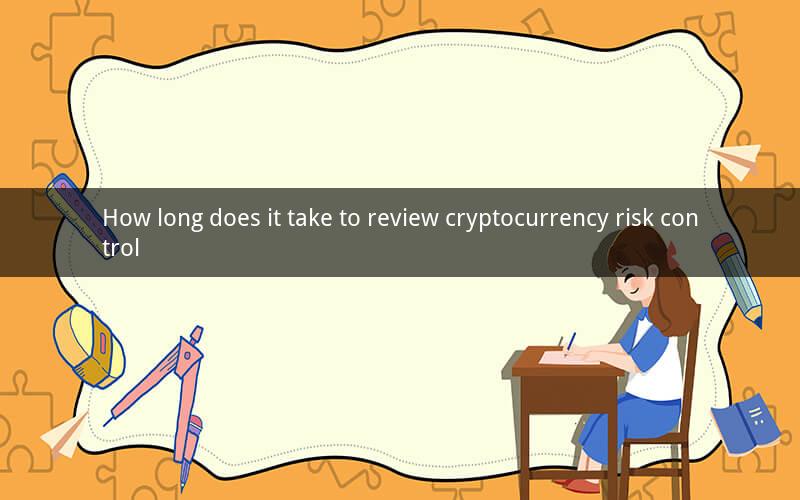
Cryptocurrency Risk Control Review Process: A Comprehensive Guide
Table of Contents
1. Introduction to Cryptocurrency Risk Control
2. Understanding the Importance of Risk Control in Cryptocurrency
3. Steps in the Cryptocurrency Risk Control Review Process
- 3.1 Initial Assessment
- 3.2 Identifying Risks
- 3.3 Assessing Risks
- 3.4 Developing Risk Mitigation Strategies
- 3.5 Implementing Risk Controls
- 3.6 Monitoring and Updating Risk Controls
4. Factors Influencing the Duration of the Review Process
5. Conclusion
1. Introduction to Cryptocurrency Risk Control
Cryptocurrency risk control is a critical aspect of managing digital assets. As the market for cryptocurrencies continues to grow, the need for effective risk control measures becomes increasingly important. This guide provides an overview of the cryptocurrency risk control review process, including the steps involved and the factors that can influence the duration of the process.
2. Understanding the Importance of Risk Control in Cryptocurrency
Risk control in cryptocurrency is essential for several reasons:
- Market Volatility: Cryptocurrencies are known for their high volatility, which can lead to significant gains or losses.
- Security Threats: The digital nature of cryptocurrencies makes them susceptible to hacking and theft.
- Regulatory Changes: The regulatory landscape for cryptocurrencies is constantly evolving, and staying compliant is crucial.
- Operational Risks: Issues such as system failures or inadequate internal controls can pose risks to cryptocurrency businesses.
3. Steps in the Cryptocurrency Risk Control Review Process
3.1 Initial Assessment
The initial assessment involves gathering information about the cryptocurrency business, including its size, complexity, and existing risk management practices. This step helps in understanding the scope of the review process.
3.2 Identifying Risks
The next step is to identify potential risks associated with the cryptocurrency business. This includes market risks, credit risks, operational risks, and regulatory risks.
3.3 Assessing Risks
Once risks are identified, they need to be assessed in terms of their likelihood and potential impact. This helps in prioritizing risks and determining which ones require immediate attention.
3.4 Developing Risk Mitigation Strategies
Based on the risk assessment, strategies to mitigate identified risks are developed. These strategies may include diversification, insurance, and operational improvements.
3.5 Implementing Risk Controls
The risk mitigation strategies are then implemented, which may involve changes to policies, procedures, and systems.
3.6 Monitoring and Updating Risk Controls
Risk controls are not static; they need to be monitored regularly to ensure they remain effective. Updates may be necessary to address new risks or changes in the business environment.
4. Factors Influencing the Duration of the Review Process
The duration of the cryptocurrency risk control review process can vary significantly based on several factors:
- Complexity of the Business: More complex businesses will require a longer review process.
- Size of the Organization: Larger organizations may have more extensive operations, leading to a longer review period.
- Regulatory Environment: Changes in regulations can require additional time for compliance.
- Availability of Resources: The availability of skilled personnel and resources can impact the review process.
- Level of Risk Exposure: Higher risk exposure may necessitate a more thorough review.
5. Conclusion
The cryptocurrency risk control review process is a comprehensive and dynamic endeavor. While the duration of the process can vary based on various factors, understanding the steps involved and the importance of each step is crucial for effective risk management. By following a structured approach and considering the unique aspects of the cryptocurrency market, businesses can better protect their assets and ensure compliance with evolving regulations.
---
Questions and Answers
1. What is the primary goal of the initial assessment in the risk control review process?
- The primary goal is to gather information about the business to understand the scope and context of the review.
2. How can market volatility affect the risk control review process?
- Market volatility can necessitate a more frequent review of risk controls and a more aggressive approach to risk mitigation.
3. What are some common operational risks in cryptocurrency businesses?
- Common operational risks include system failures, inadequate internal controls, and human error.
4. How does the regulatory environment influence the risk control review process?
- The regulatory environment can require additional time for compliance and may necessitate changes to risk control measures.
5. What is the role of risk mitigation strategies in the review process?
- Risk mitigation strategies help to reduce the likelihood and impact of identified risks.
6. How can a business prioritize risks during the assessment phase?
- Risks can be prioritized based on their likelihood and potential impact, with a focus on those that pose the greatest threat.
7. What are some examples of risk controls that can be implemented in cryptocurrency businesses?
- Examples include encryption, multi-factor authentication, regular security audits, and insurance policies.
8. How often should risk controls be monitored and updated?
- Risk controls should be monitored regularly and updated as needed, particularly in response to new risks or changes in the business environment.
9. What are the potential consequences of inadequate risk control in cryptocurrency businesses?
- Inadequate risk control can lead to financial losses, reputational damage, and legal and regulatory sanctions.
10. How can a business ensure the effectiveness of its risk control measures?
- A business can ensure effectiveness through regular audits, training employees on risk management, and staying informed about emerging risks.